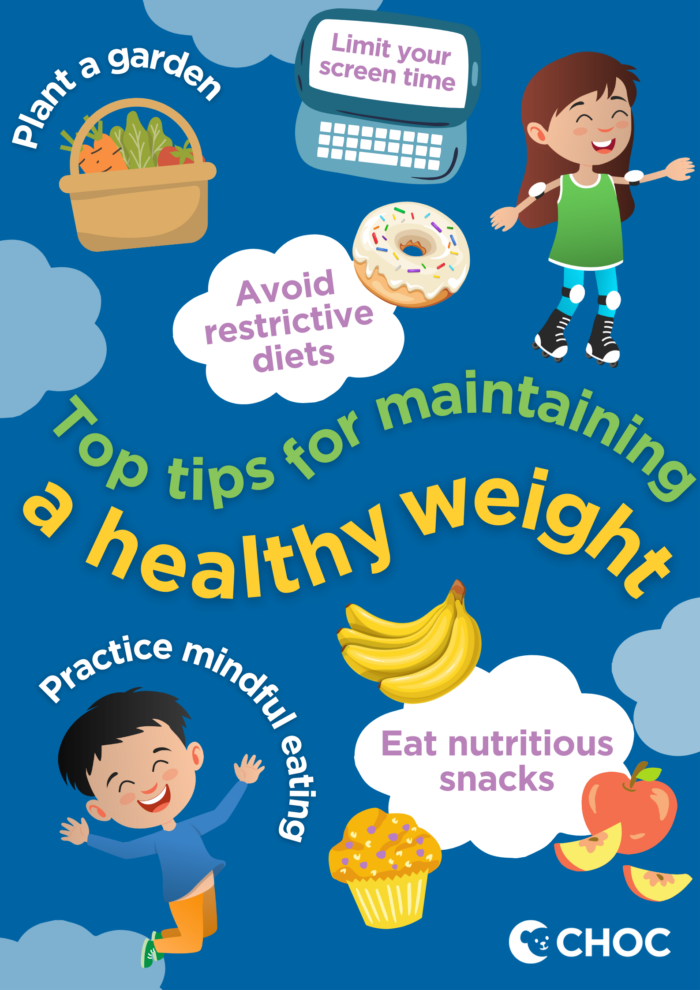How parents can help promote healthy eating and exercise habits at home
Childhood obesity rates are on the rise in the United States – affecting nearly 1 in 5 kids ages 2 to 19 years – but there are things that families can do to help prevent it.
Dr. Alexandra Roche, pediatrician and division chief of adolescent medicine at CHOC and an AAP member, explains instilling healthy eating and exercise habits in kids and teens often begins at home.
Here, she offers quick tips to parents that can help kids and teens maintain a healthy weight and prevent obesity.

 Print this to share with your kids and teens
Print this to share with your kids and teens
10 healthy eating and exercise tips to help kids and teens maintain a healthy weight
1. Avoid restrictive diets.
Intermittent fasting and keto diets are not recommended for developing teens. They are very hard to maintain and can lead to increased food cravings and nutrient deficiencies.
2. Eat meals together as a family.
When possible, eating family meals may protect against eating disorders and unhealthy eating habits.
3. Incorporate vegetables, lean proteins and whole grains into your child’s diet.
By incorporating these nutrient-rich food groups, kids and teens can feel full longer. Limiting sugar-sweetened beverages like sodas and juices is also an easy way to help eliminate excess calories.
4. Maintain a consistent schedule with eating.
Typical, consistent meal times can help prevent grazing and snacking, which often leads to excess portions.
5. Prevent stress and boredom eating.
For those struggling with stress eating, working on relaxation through deep breathing, journaling, or other coping techniques can lessen the urge to snack.
For those struggling with “boredom” eating, having a consistent schedule and snack prepping with appropriate portions is a helpful tool.
6. Prep healthy snacks.
Prepping portions of fruits and veggies can help keep healthy snacks readily available. Chips, soda and cookies should be out of sight and saved for special occasions.
7. Plant a garden.
Gardening is a great way to explore where foods come from and to promote the fun of eating vegetables. Even growing just a few herbs in a window can make “green” less intimidating. Take trips to local farms to pick your own produce and have your teens help pick out the vegetables at the market. Involve them in part of the meal planning!
8. Limit using foods as a reward.
Using food as a reward can create an unhealthy association between certain foods and emotions. Children may come to view certain foods as rewards or treats, leading to potential overconsumption of unhealthy foods and a skewed relationship with food.
9. Practice mindful eating.
Mindful eating is a great exercise to teach us to slow down when eating and enjoy every bite – which also helps promote appropriate portions. To practice this, with the first one to two bites of food, explore the following five sensations: how does it look, how does it smell, how does it sound, how does it feel and how does it taste.
10. Step away from the screen.
Encourage kids and teens take breaks from their screens, and to be active every day in ways that work for your family, like: family walks or bike rides, playing at the local park, having at-home dance parties, taking weekend hikes and having family gym time.
For more health and wellness resources from the pediatric experts at CHOC, sign up for the Kids Health newsletter.
Find a CHOC Primary Care Pediatrician
From babies to teens, pediatricians from CHOC’s Primary Care Network partner with parents to offer immunizations, sick visits, sports physicals and more.





